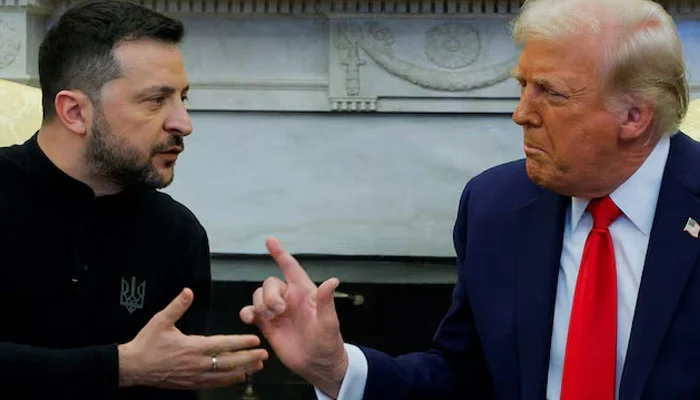On Wednesday, U.S. President Donald Trump dimmed the lights in the Oval Office and subjected South African President Cyril Ramaphosa to his latest geopolitical ambush of a foreign leader in front of television cameras.
In an extraordinary scene clearly orchestrated by the White House for maximum effect—and reminiscent of Ukrainian President Volodymyr Zelenskiy’s visit in February—Trump confronted Ramaphosa with false claims of genocide against South African whites, including allegations of mass killings and land seizures.
This was another demonstration of Trump’s apparent willingness to utilize the Oval Office, historically reserved as a place of honor for foreign dignitaries, to embarrass visitors from less-powerful nations or pressure them on issues he is intensely focused on.
Trump’s unprecedented use of the presidential setting for such displays could prompt foreign leaders to reconsider accepting his invitations and risking public humiliation—a reluctance that could make it harder to solidify ties with friends and partners also being courted by arch-rival China.
Patrick Gaspard, a former U.S. ambassador to South Africa under President Barack Obama, stated that Trump had transformed the meeting with Ramaphosa into a “shameful spectacle” and “savaged him with some fake snuff film and violent rhetoric.”
“Engaging on Trump’s terms never goes well for anyone,” Gaspard, now a senior fellow at the Center for American Progress think tank in Washington, wrote in a post on X.
The Oval Office meeting had been framed as an opportunity to reset strained relations between the U.S. and South Africa—especially following Trump’s imposition of tariffs—and to defuse escalating tensions over his unfounded accusations of “white genocide” and offers to resettle white minority Afrikaners.
After a cordial beginning to the meeting, Trump—a former reality TV star—ordered the lights dimmed and presented a video and printed articles purporting to be evidence of the persecution of white South Africans.
Ramaphosa, evidently prepared to counter Trump’s accusations but likely not anticipating the theatrical display, remained attentive and composed as he sought to refute his host’s presentation. However, he stopped short of directly challenging or criticizing a U.S. president known for being thin-skinned.
“I’m sorry I don’t have a plane to give you,” Ramaphosa quipped with a smile, referring to the luxury jetliner Qatar had offered Trump as a replacement for Air Force One.
His spokesperson, Vincent Magwenya, told South African broadcaster Newzroom Afrika that “you could see President Ramaphosa was being provoked.”
“You could see he was having his eye pulled, and he did not fall for the trap,” Magwenya said.
The White House did not immediately respond to inquiries regarding whether the meeting was designed to put Ramaphosa in a difficult position and if such tactics might discourage other foreign leaders from similar visits.
Cameron Hudson, a senior fellow at the Center for Strategic and International Studies think tank in Washington, commented that while the televised portion of the meeting was a “circus,” “it never crossed the line into anger or vitriol, so it didn’t go off the cliff.”
Zelenskiy–Trump Shouting Match
That mood stood in stark contrast to Trump’s meeting just months prior with Zelenskiy, which devolved into a shouting match involving both the president and Vice President JD Vance.
Zelenskiy, much like Ramaphosa, was there to try to mend a rift in relations—and in Ukraine’s case, to maintain U.S. military assistance to Kyiv in the war against Russia’s invading forces.
However, the meeting quickly went awry, with Trump accusing Zelenskiy of being disrespectful and gambling with a potential World War Three, and Vance alleging that the Ukrainian leader had not shown sufficient appreciation for U.S. support.
The contentious nature of that meeting sent shockwaves through the NATO alliance backing Ukraine’s resistance against Russia.
While perhaps less was at stake in Trump’s Wednesday meeting with Ramaphosa, South Africa is a major political and economic player in Africa, with China being its largest trading partner, and the U.S. ranking second.
South Africa—which endured centuries of severe discrimination against Black people during colonialism and apartheid before transitioning to a multi-party democracy in 1994 under Nelson Mandela—categorically rejects Trump’s allegations.
Trump’s confrontation appeared tailored for segments of his political base, particularly the far-right and white nationalist factions that have long promoted the narrative of a “white genocide” in South Africa.
By showcasing unverified claims of violence against white farmers and framing land reform as racial persecution, Trump tapped into talking points popular in U.S. right-wing extremist circles.
Since returning to office in January, Trump has canceled aid, expelled South Africa’s ambassador, and resettled some white minority Afrikaners based on racial discrimination claims that Pretoria asserts are baseless. The program has been divisive, given Trump’s broad restrictions on refugee admissions from other parts of the world.
A new South African land reform law—aimed at redressing the injustices of apartheid—allows for expropriations without compensation when in the public interest, for example, if land is lying fallow. No such expropriation has taken place, and any order can be challenged in court.
“If anybody doubts that the Zelenskiy incident was not completely stage-managed by the White House, I think the scales should fall from their eyes,” British foreign affairs commentator Tim Marshall told Times Radio in London.
Land Ownership Statistics in South Africa (as of 2017, more recent official data not widely available):
- White individuals: Comprise approximately 8% of South Africa’s population, but as of 2017, they owned 72% of private agricultural land. (Source: South African government’s 2017 Land Audit)
- Black individuals: Comprise approximately 80% of South Africa’s population, but as of 2017, they owned 4% of private agricultural land. (Source: South African government’s 2017 Land Audit)
- The remaining land is owned by the government, trusts, or other groups.
- In 2018, the South African Parliament passed a motion to amend the constitution to allow for land expropriation without compensation, aimed at redressing the injustices of the colonial and apartheid eras. However, as noted in the report, no such expropriation has taken place yet.



